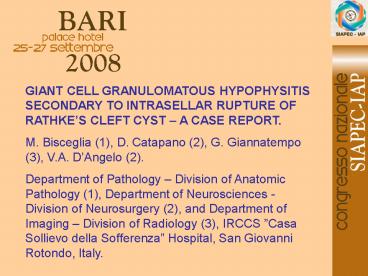Diapositiva 1
1 / 17
Title:
Diapositiva 1
Description:
... Pathology (1), Department of Neurosciences - Division of Neurosurgery (2), and ... Rathke s pouch closes in early embryonic life, but its apical extremity ... – PowerPoint PPT presentation
Number of Views:21
Avg rating:3.0/5.0
Title: Diapositiva 1
1
GIANT CELL GRANULOMATOUS HYPOPHYSITIS SECONDARY
TO INTRASELLAR RUPTURE OF RATHKES CLEFT CYST A
CASE REPORT. M. Bisceglia (1), D. Catapano (2),
G. Giannatempo (3), V.A. DAngelo
(2). Department of Pathology Division of
Anatomic Pathology (1), Department of
Neurosciences - Division of Neurosurgery (2), and
Department of Imaging Division of Radiology
(3), IRCCS Casa Sollievo della Sofferenza
Hospital, San Giovanni Rotondo, Italy.
2
Introduction.
- Rathke s pouch closes in early embryonic life,
but its apical extremity persists into postnatal
life as a cleft between the pars distalis and the
pars nervosa of the pituitary. - Rathkes cleft is a frequent incidental finding
in the normal pituitary in post-mortem specimens.
It is lined by cuboidal or columnar epithelium,
often ciliated in places and which may include
mucous goblet cells. - Rathkes cleft cysts are tumor-like lesions which
may derive from distension of clefts by
gelatinous material, but may remain asymptomatic.
- They are typically intrasellar, but dumb-bell
intra- and supra-sellar, and entirely suprasellar
examples are described. - The epithelial lining of these cysts is similar
to that of Rathkes cleft, but squamous
metaplasia is not uncommon.
3
- Large cysts may become symptomatic either due to
compression of the pituitary gland, optic chiasm,
or hypothalamus, or to inflammation of the
surrounding pituitary tissue with or without
rupture of the cyst capsule. - Hypophysitis associated with Rathkes cleft cyst
is rarely reported. - Both non-granulomatous lymphocytic hypophysitis
(1,2) and giant cell foreign-body type
granulomatous hypophysitis (3) have been
described, triggered by rupture of the cyst
capsule. - We describe an additional case of
- giant cell granulomatous hypophysitis,
- caused by a ruptured Rathkes cleft cyst.
4
Case Report.
- A 53 years-old woman presented with acute
diabetes insipidus and visual impairment. - At imaging (MRI), there was an intense
contrast-enhancing intra-supra-sellar mass with a
large cystic component compressing the optic
chiasm and the pituitary stalk.
5
Fig. 1. A and B, MRI T1-weighted image. A
sellar-suprasellar, partly cystic, lesion is
visible. The sella is enlarged and the sphenoidal
bone eroded. C and D, T1-weighted image with
contrast, showing ring enhancement around the
cyst. The pituitary stalk is thickened and
enhanced.
A
B
D
C
6
- Laboratory chemical analyses were normal.
- The patient underwent trans-sphenoidal surgery.
- Intraoperatively a firm tumor capsule was
detected surrounding a cyst cavity. - Inspissated fluid was aspirated and the tumor
capsule witht the surrounding inflammed tissue
were totally removed. - Light microscopy revealed giant cell
granulomatous hypophysitis. - Fragments of Rathkes cyst wall partly lined
by simple columnar and squamous metaplastic
epithelium were found.
7
(No Transcript)
8
(No Transcript)
9
(No Transcript)
10
(No Transcript)
11
(No Transcript)
12
CK-AE1-AE3
CK-AE1-AE3
13
Discussion.
- All the above findings strongly indicated that
the ruptured cyst had caused the giant cell
granulomatous hypophysitis. - Mucins produced by cells lining the cyst are
believed to be the direct stimulus for the giant
cell response (4). - Giant cell granulomatous hypophysitis accounts
for less than 1 of all pituitary disorders. - Two forms of giant cell granulomatous
hypophysitis are distinguished, idiopathic (5)
and secondary, the latter having varying
etiologies, including autoimmune disorders,
systemic infectious and non-infectious
granulomatous diseases (e.g. syphilis,
tuberculosis, sarcoidosis, histiocytoses,
including Langerhans cell histiocytosis) and
ruptured Rathkes cleft cyst.
14
- Histologically different is another type of
hypophysitis known as xanthomatous hypophysitis,
in which anterior pituitary is heavily
infiltrated by xanthomatous histiocytes with
macrophagic immunoprofile (6). - Todate only 7 cases of granulomatous hypophysitis
secondary to ruptured Rathkes cleft cysts are
recorded in the world literature. - All have occurred in women (3).
- All but one patient were not pregnant (3).
- We have reported herein an additional such
example, - also in a non-pregnant female.
15
Conclusion.
- Although a definite preoperative diagnosis is
almost impossible, particularly the challenging
distinction from a non-functioning pituitary
adenoma with cystic degeneration, the diagnosis
should be suspected in the presence of a sellar
mass with a cystic area. - Anticipation of the diagnosis preoperatively or
intraoperatively is important for the correct
management of this lesion.
16
References
- Nishikawa T, Takahashi JA, Shimatsu A, Hashimoto
N. Hypophysitis caused by Rathke's cleft
cyst. Case report. Neurol Med Chir (Tokyo).
200747136-9. - Schittenhelm J, Beschorner R, Psaras T, et al.
Rathke's cleft cyst rupture as potential initial
event of a secondary perifocal lymphocytic
hypophysitis proposal of an unusual pathogenetic
event and review of the literature. Neurosurg
Rev. 200831157-63. - Sonnet E, Roudaut N, Meriot P, Besson G,
Kerlan V. Hypophysitis associated with a ruptured
Rathke's cleft cyst in a woman, during pregnancy.
J Endocrinol Invest. 200629353-7.
17
- Roncaroli F, Bacci A, Frank G,
Calbucci F. Granulomatous hypophysitis caused by
a ruptured intrasellar Rathke's cleft cyst
report of a case and review of the literature.
Neurosurgery. 199843146-9 - Bhansali A, Velayutham P, Radotra BD, Pathak A.
Idiopathic granulomatous hypophysitis presenting
as non-functioning pituitary adenoma description
of six cases and review of literature. Br J
Neurosurg. 200418489-94. - Folkerth RD, Price DL Jr, Schwartz M, Black PM,
De Girolami U. Xanthomatous hypophysitis. Am J
Surg Pathol. 199822736-41.































